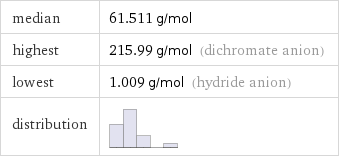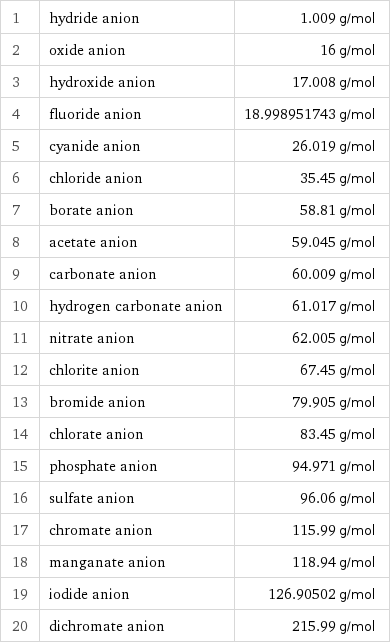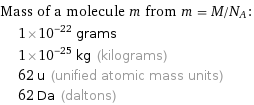Input interpretation

anions | molar mass
Summary

median | 61.511 g/mol highest | 215.99 g/mol (dichromate anion) lowest | 1.009 g/mol (hydride anion) distribution |
Units

Distribution plots

(molar mass in grams per mole)
Molar mass rankings

1 | hydride anion | 1.009 g/mol 2 | oxide anion | 16 g/mol 3 | hydroxide anion | 17.008 g/mol 4 | fluoride anion | 18.998951743 g/mol 5 | cyanide anion | 26.019 g/mol 6 | chloride anion | 35.45 g/mol 7 | borate anion | 58.81 g/mol 8 | acetate anion | 59.045 g/mol 9 | carbonate anion | 60.009 g/mol 10 | hydrogen carbonate anion | 61.017 g/mol 11 | nitrate anion | 62.005 g/mol 12 | chlorite anion | 67.45 g/mol 13 | bromide anion | 79.905 g/mol 14 | chlorate anion | 83.45 g/mol 15 | phosphate anion | 94.971 g/mol 16 | sulfate anion | 96.06 g/mol 17 | chromate anion | 115.99 g/mol 18 | manganate anion | 118.94 g/mol 19 | iodide anion | 126.90502 g/mol 20 | dichromate anion | 215.99 g/mol
Unit conversion for median molar mass 61.511 g/mol

0.061511 kg/mol (kilograms per mole)
Comparisons for median molar mass 61.511 g/mol

≈ ( 0.085 ≈ 1/12 ) × molar mass of fullerene ( ≈ 721 g/mol )

≈ 0.32 × molar mass of caffeine ( ≈ 194 g/mol )

≈ 1.1 × molar mass of sodium chloride ( ≈ 58 g/mol )
Corresponding quantities

Mass of a molecule m from m = M/N_A: | 1×10^-22 grams | 1×10^-25 kg (kilograms) | 62 u (unified atomic mass units) | 62 Da (daltons)

Relative molecular mass M_r from M_r = M_u/M: | 62